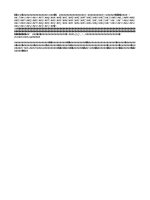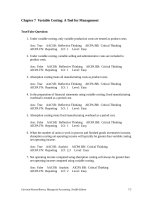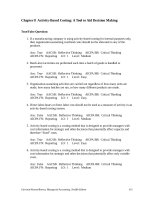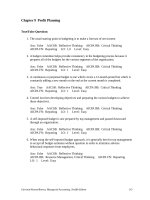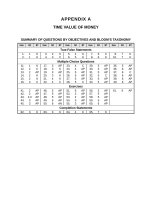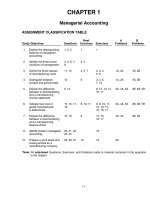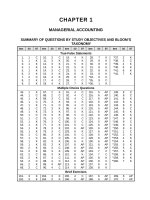Test bank managerial accounting by kieso weygandt 5e ch013
Bạn đang xem bản rút gọn của tài liệu. Xem và tải ngay bản đầy đủ của tài liệu tại đây (140.08 KB, 30 trang )
CHAPTER 13
Statement of Cash Flows
ASSIGNMENT CLASSIFICATION TABLE
Brief
Exercises
Exercises
A
Problems
B
Problems
3, 4, 5, 6, 7,
8, 9, 16
1, 2, 3
1, 2, 3
1A
1B
10, 11, 12,
13, 14
4, 5, 6, 7
4, 5, 6,
7, 8, 9
2A, 3A, 5A,
7A, 9A, 11A
2B, 3B, 5B,
7B, 9B, 11B
8, 9, 10, 11
7, 9
7A, 8A
7B, 8B
17
12
10
12A
8, 18, 19,
20, 21
13, 14, 15
11, 12,
13, 14
4A, 6A, 8A,
10A
Study Objectives
Questions
*1.
Indicate the usefulness
of the statement of
cash flows.
1, 2, 6, 15
*2.
Distinguish among
operating, investing,
and financing activities.
*3.
Prepare a statement
of cash flows using
the indirect method.
*4.
Analyze the statement
of cash flows.
*5.
Explain how to use a
worksheet to prepare the
statement of cash flows
using the indirect method.
*6.
Prepare a statement
of cash flows using
the direct method.
4B, 6B, 8B,
10B
*Note: All asterisked Questions, Exercises, and Problems relate to material contained in the appendix*to
the chapter.
13-1
ASSIGNMENT CHARACTERISTICS TABLE
Problem
Number
Description
Difficulty
Level
Time
Allotted (min.)
1A
Distinguish among operating, investing, and financing
activities.
Simple
10–15
2A
Determine cash flow effects of changes in equity accounts.
Simple
10–15
3A
Prepare the operating activities section—indirect method.
Simple
20–30
Prepare the operating activities section—direct method.
Simple
20–30
Prepare the operating activities section—indirect method.
Simple
20–30
Prepare the operating activities section—direct method.
Simple
20–30
Prepare a statement of cash flows—indirect method, and
compute free cash flow.
Moderate
40–50
Prepare a statement of cash flows—direct method, and
compute free cash flow.
Moderate
40–50
Prepare a statement of cash flows—indirect method.
Moderate
40–50
Prepare a statement of cash flows—direct method.
Moderate
40–50
Prepare a statement of cash flows—indirect method.
Moderate
40–50
Prepare a worksheet—indirect method.
Moderate
40–50
*4A
5A
*6A
7A
*8A
9A
*10A
11A
*12A
1B
Distinguish among operating, investing, and financing
activities.
Simple
10–15
2B
Determine cash flow effects of changes in plant asset
accounts.
Simple
10–15
3B
Prepare the operating activities section—indirect method.
Simple
20–30
Prepare the operating activities section—direct method.
Simple
20–30
Prepare the operating activities section—indirect method.
Simple
20–30
Prepare the operating activities section—direct method.
Simple
20–30
Moderate
40–50
*4B
5B
*6B
7B
Prepare a statement of cash flows—indirect method, and
compute free cash flow.
13-2
ASSIGNMENT CHARACTERISTICS TABLE (Continued)
Problem
Number
*8B
9B
*10B
11B
Difficulty
Level
Time
Allotted (min.)
Prepare a statement of cash flows—direct method, and
compute free cash flow.
Moderate
40–50
Prepare a statement of cash flows—indirect method.
Moderate
40–50
Prepare a statement of cash flows—direct method.
Moderate
40–50
Prepare a statement of cash flows—indirect method.
Moderate
40–50
Description
13-3
13-4
Distinguish among operating,
investing, and financing
activities.
Prepare a statement of cash
flows using the indirect
method.
Analyze the statement of
cash flows.
Explain how to use a
worksheet to prepare the
statement of cash flows
using the indirect method.
Prepare a statement of cash
flows using the direct
method.
2.
3.
4.
*5
*6.
Broadening Your Perspective
Indicate the usefulness of the
statement of cash flows.
1.
Study Objective
Q13-18
Q13-10
Q13-11
Q13-12
Q13-14
Q13-13
Q13-19 E13-13
BE13-13 E13-14
BE13-14 P13-4A
BE13-15 P13-6A
E13-11 P13-8A
E13-12 P13-10A
BE13-12
E13-10
P13-12A
E13-7
E13-9
P13-7A
P13-8A
E13-8
E13-9
P13-3A
P13-5A
P13-7A
P13-9A
BE13-7
E13-6
P13-2A
P13-2B
P13-7A
P13-7B
P13-4B P13-8A
P13-6B P13-8B
P13-8B
P13-10B
P13-7A
P13-8A
P13-7B
P13-8B
Analysis
P13-7B BE13-8
P13-8B BE13-9
BE13-10
BE13-11
P13-11A
P13-3B
P13-5B
P13-7B
P13-9B
P13-11B
Application
Exploring the Web Comparative Analysis
Decision Making Across
the Organization
Communication
Q13-8
Q13-20
Q13-21
Q13-17
BE13-2 BE13-3
E13-1 E13-2
E13-2 E13-3
P13-1A
P13-1B
Q13-3
Q13-5
Q13-7
Q13-8
Q13-9
Q13-16
Q13-4
Q13-6
BE13-1
BE13-4
BE13-5
BE13-6
E13-4
E13-5
E13-7
Q13-15
Q13-1
Q13-2
Q13-6
Knowledge Comprehension
Synthesis
Decision Making
Across the
Organization
Ethics Case
Comp. Analysis
All About You
Evaluation
Correlation Chart between Bloom’s Taxonomy, Study Objectives and End-of-Chapter Exercises and Problems
BLOOM’S TAXONOMY TABLE
STUDY OBJECTIVES
1. INDICATE THE USEFULNESS OF THE STATEMENT OF
CASH FLOWS.
2. DISTINGUISH AMONG OPERATING, INVESTING, AND
FINANCING ACTIVITIES.
3. PREPARE A STATEMENT OF CASH FLOWS USING
THE INDIRECT METHOD.
4. ANALYZE THE STATEMENT OF CASH FLOWS.
*5. EXPLAIN HOW TO USE A WORKSHEET TO PREPARE
THE STATEMENT OF CASH FLOWS USING THE
INDIRECT METHOD.
*6. PREPARE A STATEMENT OF CASH FLOWS USING
THE DIRECT METHOD.
13-5
CHAPTER REVIEW
Purpose of the Statement of Cash Flows
1.
(S.O. 1) The fourth basic financial statement is the statement of cash flows. The primary
purpose of the statement is to provide information about an entity’s cash receipts and cash
payments during a period.
2.
The information in the statement of cash flows should help investors to assess the
a. entity’s ability to generate future cash flows.
b. entity’s ability to pay dividends and meet obligations.
c. reasons for the difference between net income and net cash flow from operating activities.
d. cash investing and financing transactions during the period.
Classification of Cash Flows
3.
(S.O. 2) The statement of cash flows classifies cash receipts and cash payments by:
a. Operating activities which include cash effects of transactions that create revenues and
expenses and thus enter into the determination of net income.
b. Investing activities which include (1) acquiring and disposing of property, plant, and
equipment, (2) acquiring and disposing of investments, and (3) lending money and collecting
the loans.
c. Financing activities which involve liability and stockholders’ equity items and include
(1) obtaining cash from issuing debt and repaying the amounts borrowed, and (2) obtaining
cash from stockholders and providing them with a return on their investment.
4.
Significant noncash transactions will include the conversion of bonds into common stock and
the acquisition of assets through the issuance of bonds or capital stock. These transactions are
individually reported at the bottom of the statement of cash flows or they may appear in a
separate note or Supplementary Schedule to the financial statements.
General Format
5.
The three classes of activities constitute the general format of the statement with the operating
activities section appearing first, followed by the investing activities and financing activities sections.
a. The net cash provided or used by each activity is totaled to show the net increase (decrease)
in cash for the period.
b. The net change in cash for the period is then added to or subtracted from the beginning-ofthe-period cash balance.
c. Finally, any significant noncash investing and financing activities are reported in a separate
schedule at the bottom of the statement.
6.
The statement of cash flows is not prepared from the adjusted trial balance. The information
to prepare this statement usually comes from three sources: (a) a comparative balance sheet,
(b) the current income statement, and (c) additional information.
The Major Steps
7.
The major steps in preparing the statement are:
Step 1: Determine net cash provided/used by operating activities. This step involves analyzing
not only the current year’s income statement, but also comparative balance sheets and
selected additional data.
13-6
Step 2: Determine net cash provided/used by investing and financing activities. All other
changes in the balance sheet accounts must be analyzed to determine their effect on cash.
Step 3: Compare the net change in cash on the statement of cash flows with the change in the
cash account reported on the balance sheet to make sure the amounts agree.
8.
In performing step 1, the operating activities section must be converted from an accrual basis to
a cash basis. This may be done by either the indirect method or the direct method.
a. Both methods arrive at the same total amount for “net cash provided by operations” but they
differ in disclosing the items that comprise the total amount.
b. The indirect method is used extensively in practice.
c. The FASB has expressed a preference for the direct method.
The Indirect Method
9.
(S.O. 3) The following points 10 through 15 explain and illustrate the indirect method.
The First Step—Indirect
10.
The first step is to determine net cash provided/used by operating activities.
a. Under generally accepted accounting principles the accrual basis of accounting is used
which results in recognizing revenues when earned and expenses when incurred.
b. In order to determine cash provided from operations it is necessary to report revenues and
expenses on a cash basis. This is determined by adjusting net income for items that did not
affect cash.
11.
The operating section of the statement of cash flows should (a) begin with net income, (b) add
(or deduct) items not affecting cash, and (c) show net cash provided (or used) by operating
activities.
12.
In determining net cash provided by operating activities,
a. increases in specific current assets other than cash are deducted from net income, and
decreases are added to net income.
b. increases in specific current liabilities are added to net income, and decreases are deducted
from net income.
c. expenses for depreciation, amortization, and depletion and a loss on a sale of equipment are
added to net income, and a gain on a sale of equipment is deducted from net income.
The Second Step—Indirect
13.
The second step, net cash provided/used by investing and financing activities is generally
determined from changes in noncurrent accounts reported in the comparative balance sheet and
selected additional data.
a. If the account, Land, increases $50,000 and the transaction data indicates that land was
purchased for cash, a cash outflow from an investment activity has occurred.
b. If the account, Common Stock, increases $100,000 and the transaction data indicates that
additional capital stock was issued for cash, a cash inflow from a financing activity has
resulted.
14.
The redemption of debt and the retirement or reacquisition of capital stock are cash outflows from
financing activities.
13-7
The Third Step—Indirect
15. The third step is to determine the net change in cash on the statement of cash flows with the
change in the cash account reported on the balance sheet to make sure the amounts agree.
Analysis of the Statement of Cash Flows
16. (S.O. 4) Free cash flow describes the cash remaining from operations after adjustment for
capital expenditures and dividends. The formula for free cash flow is:
Free Cash Flow = Cash Provided by Operations – Capital Expenditures – Cash Dividends.
Use of a Worksheet
*17. (S.O. 5) A worksheet may be used to assemble and classify the data that will appear on the
statement of cash flows. The worksheet is divided into two parts:
a. Balance sheet accounts with columns for (1) end of last year balances, (2) reconciling items
(debit and credit), and end of current year balances.
b. Statement of cash flows effects with debit and credit columns. This part of the worksheet
consists of the operating, investing, and financing sections.
*18. The following guidelines are important in using a worksheet.
a. In the balance sheet section, accounts with debit balances are listed separately from those
with credit balances.
b. In the cash flow effects section, inflows of cash are entered as debits in the reconciling
columns and outflows of cash are entered as credits in the reconciling columns.
c. The reconciling items shown in the worksheet are not entered in any journal or posted to any
account.
*19. The steps in preparing a worksheet are:
a. Enter the balance sheet accounts and their beginning and ending balances in the balance
sheet accounts section.
b. Enter the data that explains the changes in the balance sheet accounts (other than cash) and
their effects on the statement of cash flows in the reconciling columns of the worksheet.
c. Enter the increase or decrease in cash on the Cash line and at the bottom of the worksheet.
This entry should enable the totals of the reconciling columns to be in agreement.
*20. The statement of cash flows is prepared entirely from the data that appears in the worksheet
under Statement of Cash Flows Effects.
Preparing the Statement of Cash Flows—The Direct Method
*21. (S.O. 6) The following points 22 through 29 explain and illustrate the direct method.
The First Step—Direct
*22. The first step is to determine net cash provided/used by operating activities by adjusting each item
in the income statement from the accrual basis to the cash basis.
a. If the income statement shows revenue of $120,000 and accounts receivable (net) increased
$20,000 during the year, cash revenue is $100,000 ($120,000 – $20,000).
b. If the income statement reports operating expenses of $60,000 but accounts payable have
increased $12,000 during the year, cash operating expenses are $48,000 ($60,000 – $12,000).
13-8
*23. In the operating activities section, only major classes of cash receipts and cash payments are
reported as follows:
a. Cash receipts from (1) sales of goods and services to customers and (2) interest and
dividends on loans and investments.
b. Cash payments (1) to suppliers, (2) to employees, (3) for operating expenses, (4) for interest,
and (5) for taxes.
*24. The formula for computing cash receipts from customers is:
Revenue
from sales
+ Decrease in accounts receivable
or
– Increase in accounts receivable
*25. The formula for computing cash payments to suppliers is:
Cost of goods
sold
+
Increase in inventory
or
– Decrease in inventory
+ Decrease in accounts payable
or
– Increase in accounts payable
*26. The formula for computing cash payments for operating expenses is:
Operating
+ Increase in prepaid expenses + Decrease in accrued expenses payable
expenses
(exclusive of
or
or
depreciation – Decrease in prepaid expenses – Increase in accrued expenses payable
expense)
*27. The formula for computing cash payments for income taxes is:
Income tax
expense
+ Decrease in income taxes payable
or
– Increase in income taxes payable
The Second Step—Direct
*28. The second step, net cash provided/used by investing and financing activities is generally
determined from changes in noncurrent accounts reported in the comparative balance sheet and
selected additional data.
The Third Step—Direct
*29. The third step is to determine the net increase or decrease in cash by determining the difference
between cash at the beginning of the year and cash at the end of the year.
13-9
LECTURE OUTLINE
A.
Usefulness of the Statement of Cash Flows.
1. The statement of cash flows provides information about the cash receipts
cash payments, and net change in cash resulting from the operating,
investing, and financing activities during a period.
2. The information in a statement of cash flows should help investors,
creditors, and others assess:
B.
a.
The entity’s ability to generate future cash flows.
b.
The entity’s ability to pay dividends and meet obligations.
c.
The reasons for the difference between net income and net cash
provided (used) by operating activities.
d.
The cash investing and financing transactions during the period.
Classification of Cash Flows.
1. The statement of cash flows classifies cash receipts and cash payments
as operating, investing, and financing activities.
TEACHING TIP
ILLUSTRATION 13-1 classifies the principal types of cash receipts and payments
as operating, investing, and financing activities.
a.
Operating activities include the cash effects of transactions that enter
into the determination of net income, such as cash receipts from
sales of goods or services and cash payments to suppliers and
employees.
13-10
b.
Investing activities include (1) acquiring and disposing of investments
and property, plant, and equipment, and (2) lending money and
collecting the loans.
c.
Financing activities include (1) obtaining cash from issuing debt and
repaying the amounts borrowed, and (2) obtaining cash from stockholders, repurchasing shares, and paying dividends.
2. Note that (1) operating activities involve income statement items, (2) investing activities involve cash flows resulting from changes in investments
and long-term asset items, and (3) financing activities involve cash flows
resulting from changes in long-term liability and stockholders’ equity
items.
TEACHING TIP
ILLUSTRATION 13-2 identifies the information sources for analyzing the cash
effects of operating, investing, and financing activities.
C.
Significant Noncash Activities.
1. Companies do not report in the body of the statement of cash flows
significant financing and investing activities that do not affect cash.
2. They report these activities in either a separate schedule at the bottom
of the statement of cash flows or in a separate note or supplementary
schedule to the financial statements.
3. Examples of significant noncash activities are:
a.
Direct issuance of common stock to purchase assets.
b.
Conversion of bonds into common stock.
c.
Direct issuance of debt to purchase assets.
d.
Exchanges of plant assets.
13-11
D.
Format of the Statement of Cash Flows.
1. The cash flows from operating activities section always appears first,
followed by the investing activities and then the financing activities
sections.
TEACHING TIP
ILLUSTRATION 13-3 presents a widely used format for the statement of cash
flows. Point out that the noncash investing and financing activities appearing as a
separate schedule at the bottom of the statement may, alternatively, be presented
in a separate note or supplementary schedule to the financial statements.
2. Companies report the individual inflows and outflows from investing and
financing activities separately.
3. The reported operating, investing, and financing activities result in either
net cash provided or used by each activity. Companies total the amounts of
net cash provided (used) by each activity, resulting in the net increase or
decrease in cash for the period. This amount is then added to or subtracted
from the beginning-of-period cash balance to obtain the end-of-period
cash balance.
E.
Preparing the Statement of Cash Flows.
1. Companies prepare the statement of cash flows differently from the three
other basic financial statements. It is not prepared from an adjusted trial
balance because the trial balance will not provide the necessary data.
The information to prepare the statement of cash flows usually comes
from three sources:
a.
Comparative balance sheets.
b.
Current income statement.
c.
Additional information.
13-12
2. Preparing the statement of cash flows from these data sources involves
three major steps:
a.
Determine net cash provided/used by operating activities by converting net income from an accrual basis to a cash basis. Determining
net cash provided/used by operating activities involves analyzing
not only the current year’s income statement but also comparative
balance sheets and selected additional data.
b.
Analyze changes in noncurrent asset and liability accounts and
record as investing and financing activities, or disclose as noncash
transactions. This step involves analyzing comparative balance sheet
data and selected additional information for their effects on cash.
c.
Compare the net change in cash on the statement of cash flows
with the change in the cash account reported on the balance sheet
to make sure the amounts agree.
3. A company must convert net income from an accrual basis to a cash
basis to determine net cash provided/used by operating activities by
using either (1) the indirect method or (2) the direct method.
TEACHING TIP
ILLUSTRATION 13-4 identifies the process of converting accrual basis net
income to net cash provided/used by operating activities. Point out to students
that either the indirect or direct method may be used to convert accrual basis net
income to a cash basis. Using either method will yield the same result.
F.
Preparing the Statement of Cash Flows—Indirect Method.
1. Step 1: Determine net cash provided/used by operating activities by
converting net income from an accrual basis to a cash basis.
a.
Under the accrual basis of accounting, net income is not the same
as net cash provided by operating activities.
13-13
b.
Companies must adjust net income to convert certain items to the
cash basis.
c.
Noncash expenses (depreciation expense, amortization, depletion)
and losses in the income statement are added back to net income
and gains are deducted which results in net cash provided by
operating activities.
TEACHING TIP
ILLUSTRATION 13-5 lists some of the typical noncash items that are either
added to or deducted from net income in calculating net cash provided /used by
operating activities.
d.
A final adjustment`in reconciling net income to net cash provided by
operating activities involves analyzing all changes in noncash
current asset and current liability accounts.
e.
Deduct from net income increases in current asset accounts, and
add to net income decreases in current asset accounts, to arrive at
net cash provided by operating activities.
TEACHING TIP
ILLUSTRATION 13-6 identifies the noncash current assets and current liabilities
that are used in adjusting net income to a cash basis.
(1) When the Accounts Receivable balance increases, cash receipts
are lower than revenue earned under the accrual basis. The
company deducts from net income the amount of the increase in
accounts receivable, to arrive at net cash provided by operating
activities.
f.
Increases in current liability accounts are added to net income, and
decreases in current liability accounts are deducted from net income,
to arrive at net cash provided by operating activities.
13-14
(1) When the Accounts Payable balance increases, operating expenses on an accrual basis are higher than they are on a cash
basis because expenses are incurred for which payment has
not taken place. The company adds to net income the amount of
the increase in accounts payable to arrive at net cash provided
by operating activities.
TEACHING TIP
ILLUSTRATION 13-7 provides a short problem example of the calculation of net
cash provided by operating activities using the indirect method. (The same
problem data will be used in Illustration 13-8 to demonstrate the direct method
calculation.)
2. Step 2: Analyze changes in noncurrent asset and liability accounts and
record as investing and financing activities, or as noncash investing and
financing activities.
a.
Increases in any noncurrent asset (Land, Building, Equipment and
Long-Term Investments) represent outflows of cash from investing
activities. Decreases represent inflows of cash from investing
activities.
b.
Increases in long-term debt (Bonds Payable) or paid-in capital
(Common Stock) accounts represent cash inflows from financing
activities. Decreases in long-term debt or paid-in capital accounts
represent cash outflows from financing activities as does the payment
of dividends.
3. Step 3: Compare the net change in cash on the statement of cash flows
with the change in the cash account reported on the balance sheet to
make sure the amounts agree.
G.
Using Cash Flows to Evaluate a Company.
1. In the statement of cash flows, cash provided by operating activities is
intended to indicate the cash-generating capability of the company.
13-15
2. Cash provided by operating activities fails to take into account that a
company must invest in new fixed assets just to maintain its current level
of operations.
3. Free cash flow is a measurement that provides additional insight
regarding a company’s cash generating ability.
4. Free cash flow is calculated as cash provided by operating activities less
capital expenditures and cash dividends.
*H. Preparing the Worksheet—Indirect Method.
The steps in preparing a worksheet are:
*I.
a.
Enter in the balance sheet accounts section the balance sheet
accounts and their beginning and ending balances.
b.
Enter in the reconciling columns of the worksheet the data that
explain the changes in the balance sheet accounts other than cash
and their effects on the statement of cash flows.
c.
Enter on the cash line and at the bottom of the worksheet the
increase or decrease in cash. This entry should enable the totals of
the reconciling columns to be in agreement.
Statement of Cash Flows—Direct Method.
1. Step 1: Determine the net cash provided/used by operating activities by
converting net income from an accrual basis to a cash basis.
a.
Companies compute net cash provided by operating activities by
adjusting each item in the income statement from the accrual basis
to the cash basis.
(1) Increase in accounts receivable: when accounts receivable
increase during the year, revenues on an accrual basis are
higher than cash receipts from customers.
13-16
(2) Increase in accounts payable: when accounts payable increase
during the year, purchases on an accrual basis are higher than
they are on a cash basis.
b.
Companies report only major classes of operating cash receipts
and cash payments; the difference between cash receipts and cash
payments is the net cash provided by operating activities.
TEACHING TIP
ILLUSTRATION 13-8 provides a short in-class example of the calculation of net
cash provided by operating activities using the direct method. It is based on the
same problem data as Illustration 13-7 (indirect method). Point out to the students
that either the direct or indirect method yields the same net cash from operating
activities.
2. Step 2: Analyze changes in noncurrent asset and liability accounts and
record as investing and financing activities, or as significant noncash
activities.
a.
Increases in any noncurrent assets (Land, Building, Equipment and
Long-Term Investments) represent outflows of cash from investing
activities. Decreases represent inflows of cash from investing
activities.
b.
Increases in long-term debt (Bonds Payable) or paid-in capital
accounts (Common Stock) represent cash inflows from financing
activities. Decreases in long-term debt or paid-in capital accounts
represent cash outflows from financing activities as does the
payment of dividends.
3. Step 3: Compare the net change in cash on the statement of cash flows
with the change in the cash account reported on the balance sheet to
make sure the amounts agree.
13-17
20 MINUTE QUIZ
Circle the correct answer.
True/False
1.
Inflows and outflows from investing and financing activities should be reported separately
on the statement of cash flows.
True
2.
In addition to the adjusted trial balance, information for the statement of cash flows is taken
from comparative balance sheets and the current income statement.
True
3.
False
The amortization of a patent is added back to net income to arrive at net cash provided
by operating activities.
True
10.
False
The only use of a statement of cash flows is to help investors, creditors, and others assess
the reasons for the difference between net income and net cash provided by operating
activities.
True
9.
False
A statement of cash flows starts with net income and adds (or deducts) items that did not
affect cash to arrive at net cash provided by operating activities if the indirect method is
used.
True
8.
False
Cash outflows to purchase property, plant, and equipment would be reported in the investing
section of the statement of cash flows.
True
7.
False
When accounts receivable increases during the year, revenues on a cash basis are
higher than revenues on an accrual basis.
True
6.
False
An increase in equipment will increase net cash provided by operating activities.
True
5.
False
The purchase of inventory and investments in property, plant, and equipment are considered
cash outflows from operations.
True
4.
False
False
The issuance of shares of stock for plant assets is a significant noncash transaction.
True
False
13-18
Multiple Choice
1.
A company has credit sales of $900,000 and cash sales of $540,000 during the same
year that the Accounts Receivable account decreased by $120,000. What was the total
of cash receipts from sales?
a. $1,320,000.
b. $1,560,000.
c. $1,020,000.
d. $780,000.
2.
Cash inflows from investing activities include
a. sale of common stock.
b. purchase of equipment.
c. sale of land.
d. issuance of long-term debt.
3.
Operating activities do not include cash
a. inflows from revenue.
b. inflows from sale of equipment.
c. outflows for income taxes.
d. outflows for wages.
4.
Which of the following would decrease net cash provided by operating activities?
a. Decrease in short-term notes payable.
b. Depreciation expense.
c. Decrease in inventory.
d. Loss on sale of equipment.
5.
Noncash investing and financing activities
a. may represent significant investing and financing activities.
b. do not involve cash receipts or cash payments.
c. are disclosed on a separate schedule.
d. all of the above.
13-19
ANSWERS TO QUIZ
True/False
1.
2.
3.
4.
5.
True
False
False
False
False
6.
7.
8.
9.
10.
True
True
False
True
True
Multiple Choice
1.
2.
3.
4.
5.
b.
c.
b.
a.
d.
13-20
ILLUSTRATION 13-1
TYPICAL RECEIPTS AND PAYMENTS
CLASSIFIED BY ACTIVITY
Operating activities – Income statement items
Cash inflows:
From sale of goods or services.
From interest received and dividends received.
Cash outflows:
To suppliers for inventory.
To employees for services.
To government for taxes.
To lenders for interest.
To others for expenses.
Investing activities – Changes in investments
and long-term assets
Cash inflows:
From sale of property, plant, and equipment.
From sale of investments in debt or equity securities of
other entities.
From collection of principal on loans to other entities.
Cash outflows:
To purchase property, plant, and equipment.
To purchase investments in debt or equity securities of
other entities.
To make loans to another entity.
Financing activities – Changes in long-term liabilities
and stockholders’ equity
Cash inflows:
From sale of common stock.
From issuance of debt (bonds and notes).
Cash outflows:
To stockholders as dividends.
To redeem long-term debt or reacquire capital stock
(treasury stock).
13-21
ILLUSTRATION 13-2
INFORMATION SOURCES FOR ACTIVITIES
OPERATING ACTIVITIES
Analyze income
statement items
Changes in noncash current
asset and current liability items
INVESTING ACTIVITIES
Analyze increases and
decreases in noncurrent
asset items
FINANCING ACTIVITIES
Analyze increases and
decreases in noncurrent liability
and stockholders’ equity items
13-22
ILLUSTRATION 13-3
FORMAT OF THE STATEMENT OF CASH FLOWS
COMPANY NAME
Statement of Cash Flows
Period Covered
Cash flows from operating activities
(List of individual items)
Net cash provided (used) by operating activities
XX
Cash flows from investing activities
(List of individual inflows and outflows)
Net cash provided (used) by investing activities
XX
Cash flows from financing activities
(List of individual inflows and outflows)
Net cash provided (used) by financing activities
XX
XXX
XXX
XXX
Net increase (decrease) in cash
XXX
Cash at beginning of period
XXX
Cash at end of period
XXX
Noncash investing and financing activities
(List of individual noncash transactions)
XXX
13-23
ILLUSTRATION 13-4
CONVERTING NET INCOME TO NET CASH PROVIDED
(USED) BY OPERATING ACTIVITIES
Accrual Basis of Accounting
Earned
Revenues
Cash Basis of Accounting
Adjust Revenues
to Cash Receipts
Net
Income
Incurred
Expenses
INDIRECT METHOD
Adjust Expenses to
Cash Disbursements
OR
Net Cash
Provided by
Operating
Activities
DIRECT METHOD
1. Adjust each item on
the income statement
from the accrual basis
to the cash basis.
2. Major classes of
operating cash receipts
and cash payments are
reported.
1. Begin with net income
and adjust for income
statement items that
did not affect cash.
2. Reconcile net income
to net cash provided
(used) by operating
activities.
13-24
13-25
All noncash expenses are added to net income, and all noncash revenues are
subtracted from net income.
Adjustments for
noncash charges,
gains and losses
Noncash charges, gains and losses
Depreciation expense
Patent amortization expense
Depletion expense
Loss on sale of equipment
Gain on sale of equipment
Add to
(Deduct from)
Net Income
Add
Add
Add
Add
Deduct
Adjustments to convert net
income to net cash provided
by operating activities.
ILLUSTRATION 13-5
OPERATING ACTIVITIES—INDIRECT METHOD
ADJUSTMENTS FOR NONCASH ITEMS
